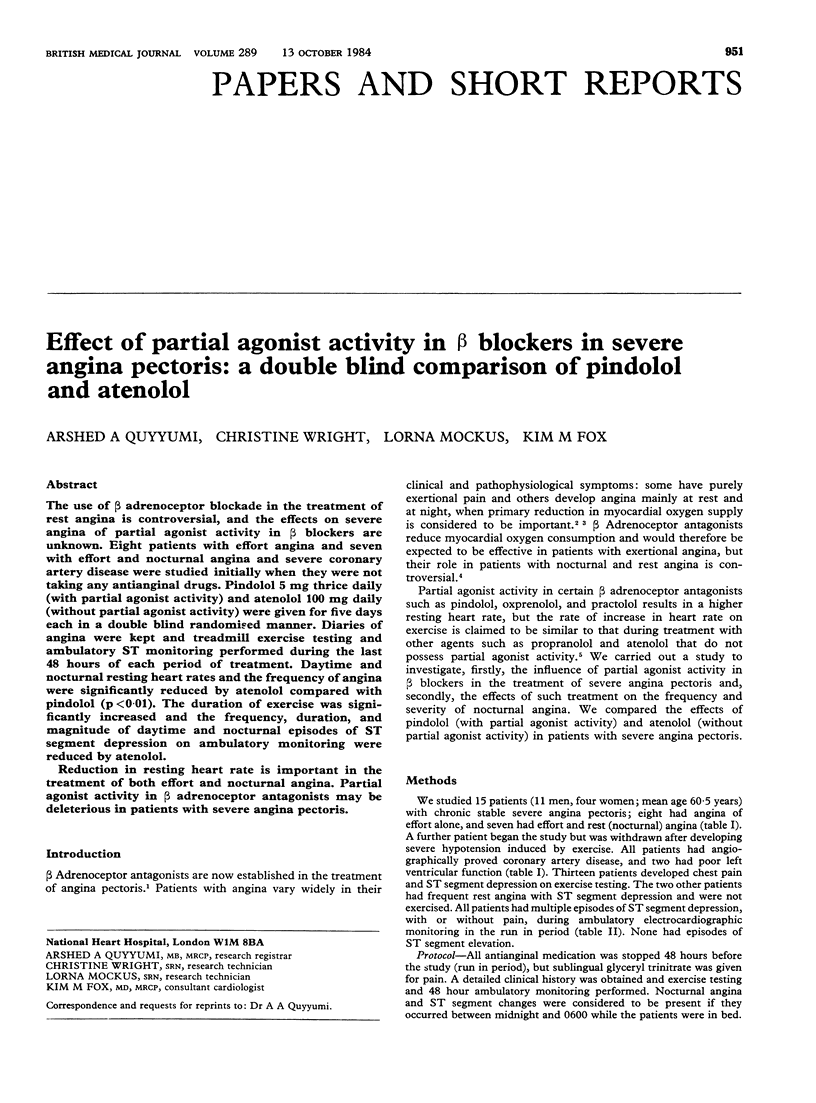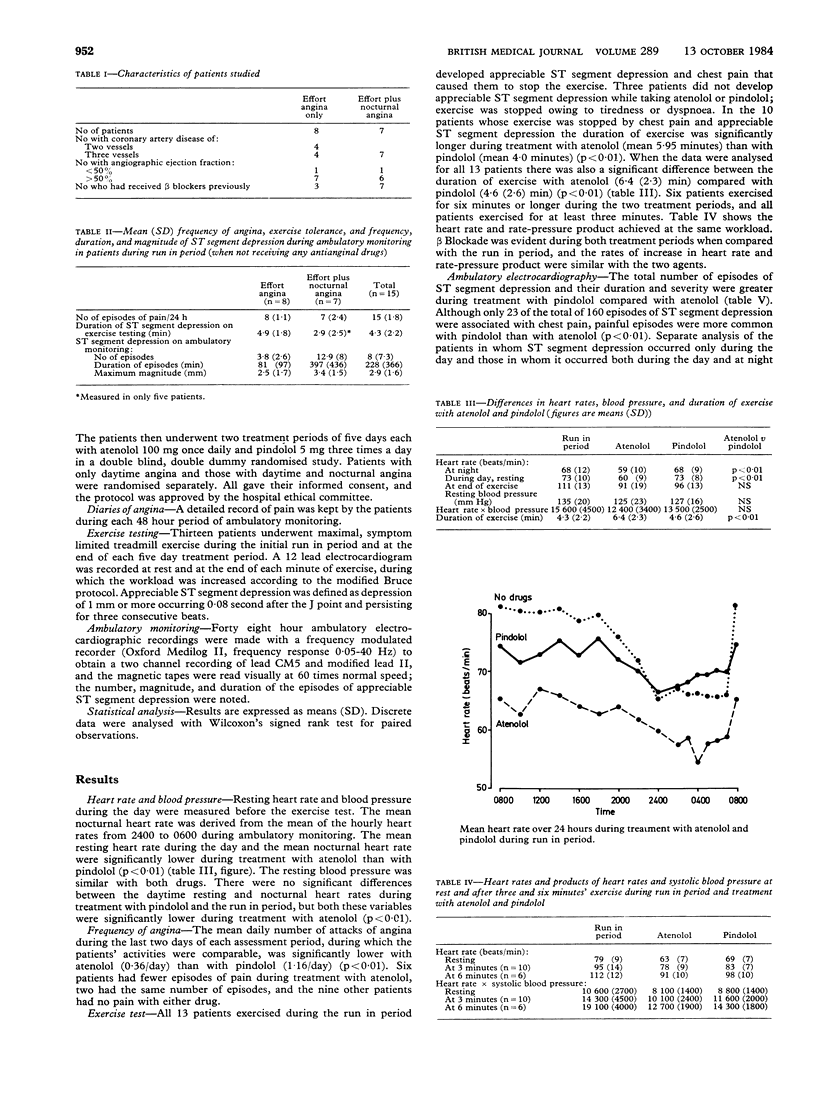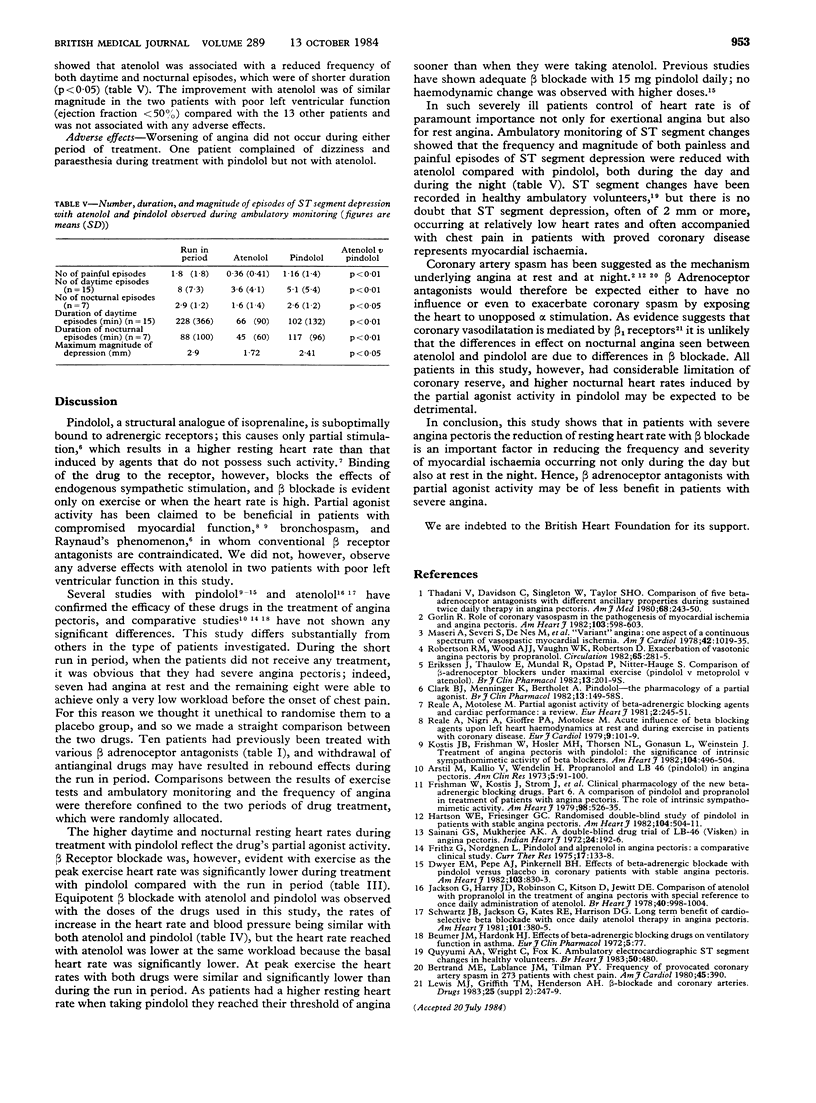Abstract
The use of beta adrenoceptor blockade in the treatment of rest angina is controversial, and the effects on severe angina of partial agonist activity in beta blockers are unknown. Eight patients with effort angina and seven with effort and nocturnal angina and severe coronary artery disease were studied initially when they were not taking any antianginal drugs. Pindolol 5 mg thrice daily (with partial agonist activity) and atenolol 100 mg daily (without partial agonist activity) were given for five days each in a double blind randomised manner. Diaries of angina were kept and treadmill exercise testing and ambulatory ST monitoring performed during the last 48 hours of each period of treatment. Daytime and nocturnal resting heart rates and the frequency of angina were significantly reduced by atenolol compared with pindolol (p less than 0.01). The duration of exercise was significantly increased and the frequency, duration, and magnitude of daytime and nocturnal episodes of ST segment depression on ambulatory monitoring were reduced by atenolol. Reduction in resting heart rate is important in the treatment of both effort and nocturnal angina. Partial agonist activity in beta adrenoceptor antagonists may be deleterious in patients with severe angina pectoris.
Full text
PDF


Selected References
These references are in PubMed. This may not be the complete list of references from this article.
- Arstila M., Kallio V., Wendelin H. Propranolol and LB 46 (prinodolol) in angina pectoris. A comparative long-term ergometric study. Ann Clin Res. 1973 Apr;5(2):91–100. [PubMed] [Google Scholar]
- Dwyer E. M., Jr, Pepe A. J., Pinkernell B. H. Effects of beta-adrenergic blockade with pindolol versus placebo in coronary patients with stable angina pectoris. Am Heart J. 1982 May;103(5):830–833. doi: 10.1016/0002-8703(82)90395-7. [DOI] [PubMed] [Google Scholar]
- Frishman W., Kostis J., Strom J., Hossler M., Elkayam U., Goldner S., Silverman R., Davis R., Weinstein J., Sonnenblick E. Clinical pharmacology of the new beta-adrenergic blocking drugs. Part 6. A comparison of pindolol and propranolol in treatment of patients with angina pectoris. The role of intrinsic sympathomimetic activity. Am Heart J. 1979 Oct;98(4):526–535. doi: 10.1016/0002-8703(79)90261-8. [DOI] [PubMed] [Google Scholar]
- Frithz G., Nordgren L. Pindolol and alprenolol in angina pectoris: a comparative clinical study. Curr Ther Res Clin Exp. 1975 Feb;17(2):133–138. [PubMed] [Google Scholar]
- Gorlin R. Role of coronary vasospasm in the pathogenesis of myocardial ischemia and angina pectoris. Am Heart J. 1982 Apr;103(4 Pt 2):598–603. doi: 10.1016/0002-8703(82)90463-x. [DOI] [PubMed] [Google Scholar]
- Harston W. E., Friesinger G. C. Randomized double-blind study of pindolol in patients with stable angina pectoris. Am Heart J. 1982 Aug;104(2 Pt 2):504–511. doi: 10.1016/0002-8703(82)90147-8. [DOI] [PubMed] [Google Scholar]
- Jackson G., Harry J. D., Robinson C., Kitson D., Jewitt D. E. Comparison of atenolol with propranolol in the treatment of angina pectoris with special reference to once daily administration of atenolol. Br Heart J. 1978 Sep;40(9):998–1004. doi: 10.1136/hrt.40.9.998. [DOI] [PMC free article] [PubMed] [Google Scholar]
- Kostis J. B., Frishman W., Hosler M. H., Thorsen N. L., Gonasun L., Weinstein J. Treatment of angina pectoris with pindolol: the significance of intrinsic sympathomimetic activity of beta blockers. Am Heart J. 1982 Aug;104(2 Pt 2):496–504. doi: 10.1016/0002-8703(82)90146-6. [DOI] [PubMed] [Google Scholar]
- Maseri A., Severi S., Nes M. D., L'Abbate A., Chierchia S., Marzilli M., Ballestra A. M., Parodi O., Biagini A., Distante A. "Variant" angina: one aspect of a continuous spectrum of vasospastic myocardial ischemia. Pathogenetic mechanisms, estimated incidence and clinical and coronary arteriographic findings in 138 patients. Am J Cardiol. 1978 Dec;42(6):1019–1035. doi: 10.1016/0002-9149(78)90691-4. [DOI] [PubMed] [Google Scholar]
- Reale A., Motolese M. Partial agonist activity of beta-adrenergic blocking agents and cardiac performance: a review. Eur Heart J. 1981 Jun;2(3):245–251. doi: 10.1093/oxfordjournals.eurheartj.a061202. [DOI] [PubMed] [Google Scholar]
- Reale A., Nigri A., Gioffrè P. A., Motolese M. Acute influence of different beta-blocking agents upon left heart hemodynamics at rest and during exercise in patients with coronary artery disease. Eur J Cardiol. 1979 Feb;9(2):101–109. [PubMed] [Google Scholar]
- Robertson R. M., Wood A. J., Vaughn W. K., Robertson D. Exacerbation of vasotonic angina pectoris by propranolol. Circulation. 1982 Feb;65(2):281–285. doi: 10.1161/01.cir.65.2.281. [DOI] [PubMed] [Google Scholar]
- Schwartz J. B., Jackson G., Kates R. E., Harrison D. C. Long-term benefit of cardioselective beta blockade with once-daily atenolol therapy in angina pectoris. Am Heart J. 1981 Apr;101(4):380–385. doi: 10.1016/0002-8703(81)90125-3. [DOI] [PubMed] [Google Scholar]
- Thadani U., Davidson C., Singleton W., Taylor S. H. Comparison of five beta-adrenoreceptor antagonists with different ancillary properties during sustained twice daily therapy in angina pectoris. Am J Med. 1980 Feb;68(2):243–250. doi: 10.1016/0002-9343(80)90361-7. [DOI] [PubMed] [Google Scholar]


